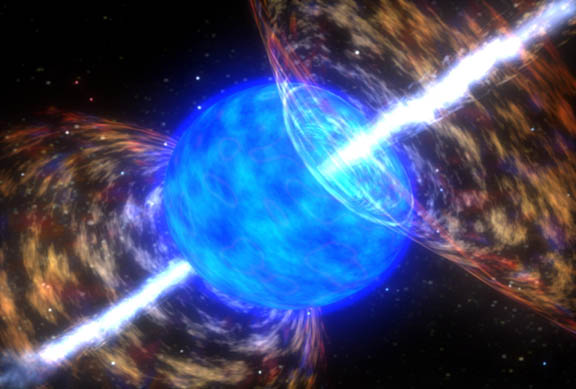New type of cosmic explosion discovered
A new type of ‘exceptionally powerful and long-lived’ cosmic explosion has been discovered by a team led by the University of Warwick.
While most gamma-ray bursts are over in about a minute, these newly discovered explosions create high energy gamma-ray bursts that last for several hours.
The international team of scientists, led by Dr Andrew Levan at the University, suggested that the long-lasting powerful gamma-ray burst is caused by the sheer size of a supergiant (a star 20 times more massive than the sun) exploding in a supernova.
Most stars that create gamma-ray bursts are thought to be relatively small and dense, thus the explosion that destroys them closes into the star in a matter of seconds.
In the case of supergiants, it takes longer for the explosion to propagate through the star, so the gamma-ray burst lasts for much longer.
The first known occurrence of the long-lasting gamma-ray burst was on Christmas Day 2010, but a lack of measurement for the distance meant that its cause was uncertain.
It was suggested that the explosion was caused by an asteroid shredded by the gravity of a dense neutron star in our galaxy.
It has further been considered that it was caused by a supernova in a galaxy 3.5 billion light years away.
However, more examples of these cosmic explosions showed that the Christmas Day burst took place in a galaxy much further away than previously thought.
Theory suggests that a large Wolf-Rayet star collapses into a core point of dense matter, a black hole.
Matter is drawn into the star’s core and energy is released in the form of “a jet of gamma-ray rays”, which is what is observed as gamma-ray bursts.
These jets are ejected extremely quickly, close to the speed of light, otherwise the material would fall back into the core.
Yet the enormity of supergiant stars means that it takes longer for the star to be drawn into its core, so the jets keep going for longer, hence the longer duration of its gamma-ray bursts.
Dr Levan commented on the discovery:
“It really shows us that the Universe is a much more violent and varied place than we’d imagined.”
Nial Tanvir, a professor at the University of Leicester and second author of the study, added:
“Predicting the detailed behaviour of matter falling into a black hole in these circumstances turns out to be very difficult.
“From a theoretical point of view we didn’t initially expect explosions at all.
“The amazing thing is that nature seems to have found ways of blowing up a wide range of stars in the most dramatic and violent way.”

Comments